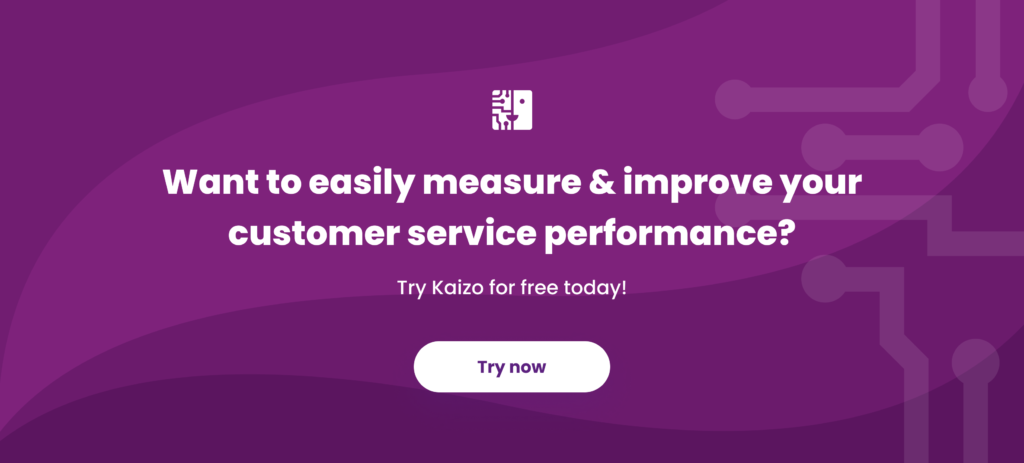When developing or optimizing your customer service strategy, it’s crucial to define your key performance indicators (KPIs) and customer service metrics.
A metric is the data that helps you and your team understand where you are, where you want to go, and how you’ll get there and align with your company’s goals. Your customer service KPIs should provide a focus for strategic and operational improvement, create an analytical basis for decision making, and help focus attention on what matters most.
Measuring data for customer service isn’t always straightforward. In this article, we’ll review the importance of customer service metrics, the key metrics to measure, and how to use them to drive performance.
What are customer service metrics?
Customer service metrics and KPIs are the numbers that help you measure how well you’re delivering on your business’s brand promise. They’re more than just a set of statistics, though—they’re also a set of principles and standards. When you set clear targets for yourself regarding how quickly you answer customer calls or how many support tickets you’ll close out each week, they’re like mile markers on the road to success with your customers.
In other words, metrics and key performance indicators are the lingua franca of the customer service industry. They’re a set of standard measurements that allow you to compare your operation’s performance against others. When you can quickly see how your operations stack up against those of your competitors, you have a much better idea of where to spend time and money on things that will have the biggest impact on your business’s success.
To figure out what metrics will work best for your company, think about why customers come to you in the first place: what is it about your products or services that sets you apart from your competitors? What does the customer experience look like from their point of view? Then, decide what would be most important to them in terms of whether or not they would continue doing business with your company. Turn these ideas into specific metrics for your business so that everyone who deals with customers can understand exactly what needs to be done to keep them happy and engaged.
Why is it important to measure customer service metrics and KPIs?
Customer service metrics give you a way to measure your business from a customer’s point of view. They provide insights on how customers are interacting with your business, what they’re saying about you, and how well your company is responding to their concerns. They also allow you to assess the overall health of your business. For instance, if your customer service call volume is steadily climbing month after month, it could mean that customers are having more issues with your products or services than in previous years. Or if customer satisfaction scores are falling, it could mean that customers feel that the quality of their interactions has declined.
Metrics help you stay on top of what’s going on in your business and make sure that when issues arise, they’re addressed quickly. They can also help prevent problems before they happen by identifying where there might be opportunities for improvement.
Without knowing the end goal (ie. what your customer service team is working towards), there will be no way to measure performance and progress. Creating a plan will guide you and your team to the specific goals you want to achieve.
Here are a few more reasons why measuring customer service performance metrics and KPIs is important:
Measure and improve agents’ performance
Depending on your team goals, you’ll want to have a specific number of metrics to work toward. Much like a game, an agent’s performance can be quantified. Identifying the metrics you’ll measure helps encourage them to achieve their targets and have fun while doing it and ultimately, agents will perform much better.
Increase operational efficiency
Having an understanding of your team’s performance lets you know where and when to delegate resources. It will also show you where you need to train more and where you’re exceeding expectations.
Improve customer satisfaction scores
Your Customer Satisfaction Score (CSAT) determines exactly how happy your customers are with your team’s service. It’s vital to find out what could make customers more satisfied and what disappointed them so you can improve and encourage customer loyalty. In fact, research done by Frederick Reichheld of Bain & Company shows increasing customer retention rates by 5% can increase profits by 25%-95%.
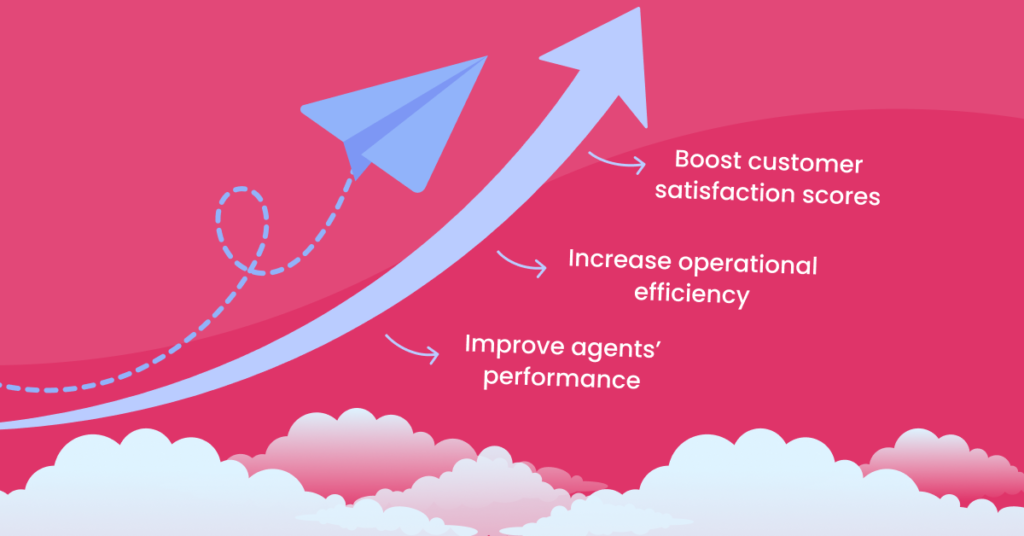
Leading vs Lagging performance indicators
Using performance indicators will help you identify exactly what, how, and when to measure data as well as give your team direction. Without knowing your KPIs, you cannot understand the reasons a customer may be unhappy, where your agents are falling behind, or how to fix it.
When identifying what indicators to use in your data, there are two types: leading and lagging.
- Leading indicators are metrics that give an early indication of performance, allowing you to proactively steer your team’s performance. An example might be tracking your agents’ first contact resolution rates.
- Lagging indicators are the metrics used to measure the overall business impact of your customer support quality. Results take longer to measure, but these indicators can give you a better understanding of how well you’ve achieved your overall goals. An example of a lagging metric is CSAT scores.
The key is to calculate leading and lagging indicators together. For example, you can look at overall CSAT scores (lagging) and the first contact resolution rates (leading) to determine if customer service quality is affecting the company’s overall goals.
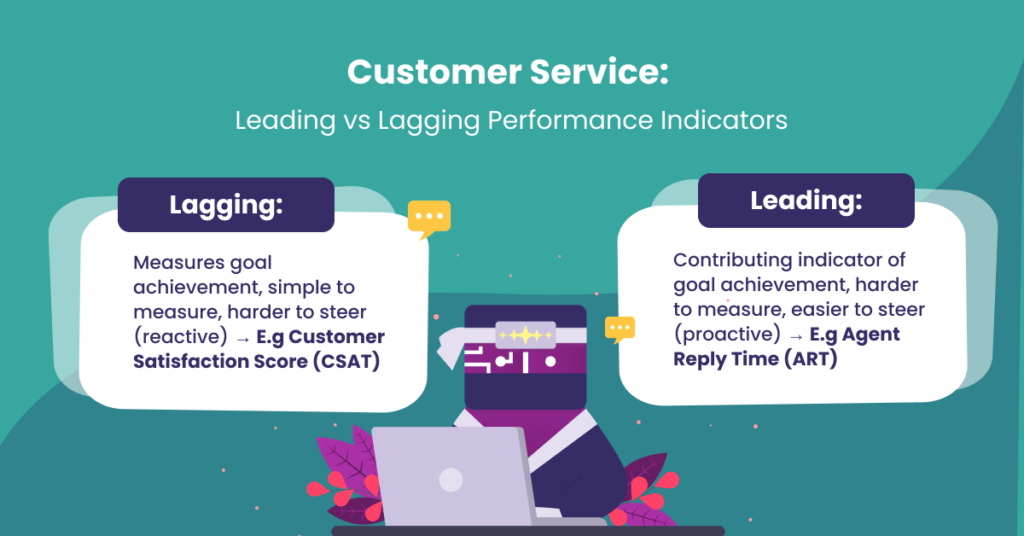
12 customer service metrics every support lead should be using
One of the most important aspects of measuring progress is monitoring and analyzing results. Here, we’ll explain the most important and common KPI metrics for customer service as well as how and when to use them.
Service quality metrics
Understanding the customer’s happiness with your service quality helps you keep a pulse on what’s important to them. Here are the top metrics you should consider:
1. Customer Satisfaction Score (CSAT)
Your CSAT is meant to identify exactly how happy customers are with your support. It is determined by the following calculation.
Once you have the data, take the overall number of satisfied customers having first internally identified what a satisfied customer is, such as a 7-10 rating out of 10, divide it by the total number of customers who filled out the survey, and multiply that number by 100. This percentage can be tracked over time to determine if you’re improving your score.
CSAT= Total number of satisfied customers ÷ Total number of responses x 100
Pro tip: This KPI helps you understand your score across all customers and will help you determine where agents can improve. But CSAT scores only show you half the picture, that’s why quality assurance in customer service is also important.

2. Negative Response Rate (NRR)
Determining your NRR (aka DSAT or BADSAT) will help you measure the number of negative customer reviews an agent or team receives vs the positive reviews as a percentage. This will be the inverse of an agent’s CSAT score. So if an agent’s score is 70%, their NRR will be 30%.
NRR= Negative customer reviews ÷ All customer reviews
Bad customer service reviews are extremely important to help identify specific areas that are negatively affecting your customer’s experience. However, oftentimes these negative reviews are given for reasons out of an agent’s control, yet are still detrimental to their CSAT score. That’s why Kaizo created an NRR feature that allows agents to challenge these reviews allowing them to receive their true CSAT.
Pro Tip: If an agent’s NRR is increasing, you’ll want to look at what the cause may be. Are they handling a lot of tickets that have no solution? Or do they need more training? Whatever the reason is, once you know it you can either work on finding a solution for the issues that the agent is unable to resolve or provide more training to help them improve their CSAT.

3. Reopen Rate (RR)
Your RR helps represent the percentage of solved tickets that have been reopened by a customer reply. These are tickets that were solved initially but are automatically reopened by a customer replying to (or calling back about) a previously solved ticket.
You can calculate the percentage by the following formula:
RR= Reopened tickets ÷ Total tickets solved x 100
Pro tip: Understanding your RR will help you identify knowledge gaps in your team. You can use this information to improve your quality feedback by adding more questions to ask customers, explaining more ways to add value to responses, or changing processes to assist both agents and customers.
Solution quality metrics
How efficiently can you make sure the customer is satisfied and helped fully? Here are some metrics to consider:
4. First Contact Resolution (FCR)
Also known as one-touch resolution, FCR is when a ticket is resolved within one interaction and a customer does not re-open it. It will help you determine if your agents are understanding and addressing the customer’s problem(s) efficiently.
FCR= Issues resolved on first contact ÷ Total no issues x 100
The Ascent Group shows that 60% of companies that measure FCR for one year or more report a one to 30% improvement in their performance.
Pro Tip: If the customer’s problem is frequently not resolved during their first interaction with your support team, you can categorize these with tags and provide agents with training or scripts to specifically touch on the issues that are causing reopens. Over time, this will help improve their resolution rates.

5. Comments to Solve
Depending on how many replies the customer service agent needs to send, this number’s average can tell you how knowledgeable the agent is, the quality of their responses, and the effectiveness of their solutions. The more interactions the customer must have with your team, the less satisfied they will be.
Pro Tip: Learning the number of contacts agents have on average with each customer will help you see where more training is necessary. The key is to help agents with higher touch points reduce this by creating macros for commonly asked questions.

6. Internal QA Score
While CSAT scores help you measure customer service externally, quality assurance is an important way to measure customer service internally. Improving your overall QA score may mean something different for each company, so ensure you focus your positive and negative feedback on aligning with the team’s quality criteria and goals.
Pro Tip: Set up a QA framework to define what success looks like for you and your team. Track the metrics that are most relevant and consistently improve processes and training.
Recommended Reading
Handling speed metrics
Whether you lead a team of two support agents or 20, understanding how quickly they’re able to respond to customers is essential. Use these customer service metrics to identify lag times, rate of responses, or resolve rates to boost the customer experience.
7. First Reply Time (FRT)
Also called first response time, FRT is the number of minutes or hours elapsed between the time a customer submits a case and the time your agent responds. It’s best measured in business hours, so no one is penalized for time off the clock.
Calculate your FRT by taking the total number of chosen time metrics (hours, minutes, etc.) and dividing it by the total number of resolved cases.
FRT= Total time waiting for all inquiries ÷ Total number of inquiries
Pro Tip: Determine which numbers you may need to exclude like automated email responses and non-business hours to get an accurate number.
8. Average Agent Reply Time (AART)
The average handling time between a customer submitting a query and an agent’s response is determined in this metric. The longer the wait, the more impatient and unhappy a customer gets.
According to Hubspot, 90% of customers rate an “immediate” response as important or very important when they have a customer service question; 60% of customers define “immediate” as 10 minutes or less. Calculate this metric by dividing the total customer time spent waiting for a reply by the number of customer messages needing a reply.
Pro Tip: Analyze the average reply time for each agent, region, and/or team to determine areas for improvement in different categories.
9. Average Resolution Time (ART)
This is the measurement for how long it takes a customer to resolve their issue(s). If it takes a long time or they receive no resolution at all, this will negatively impact CSAT scores.
To determine this number, divide the total sum of all times to resolution by the total number of cases resolved.
ART= Total time for all resolutions ÷ Total number of cases resolved
Pro Tip: While it might take some manual work, finding out where the most time is being spent will help you understand the full conversation journey and timeline. Look at this data for a specific number of conversations to discover where you’re losing time.
For example, review 10-20 conversations and if you notice a bottleneck is caused by a specific question or agent, you’ll have a better understanding of the cause and can implement a solution.
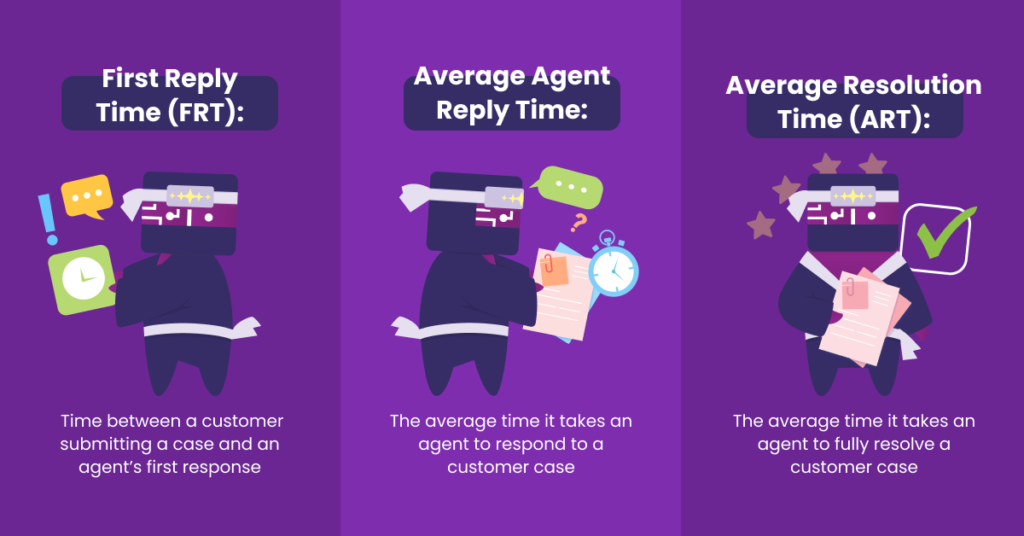
Volume metrics
Seeing your numbers from the big picture view will show you exactly how many tickets your team is handling and how you can manage your resources.
10. Total Tickets Solved
Reviewing the total number of tickets solved helps you measure how productive and effective your team is.
If you’ve successfully lowered your ART, you’re potentially increasing the total number of solved tickets, too. There will, of course, be a cap based on the number of agents, but the overall amount should ideally be increasing if ART is improving.
Pro Tip: If the numbers are not increasing, return to the service and solution metrics and re-analyze them from a different angle.
11. Handled Tickets by Channel
Tickets can come from a variety of channels, so you’ll want to track them by source. Here are a few channels customer service teams commonly use:
- Phone
- Live chat
- Social
- Voice
No matter the source, totaling the number of tickets completed by channel tells you where your agents spend their time and customers’ preferred way of contacting you.
Pro Tip: Identifying where your customers are coming from will help you see where you should spend more time. Make it a higher priority to respond to customers on these channels.
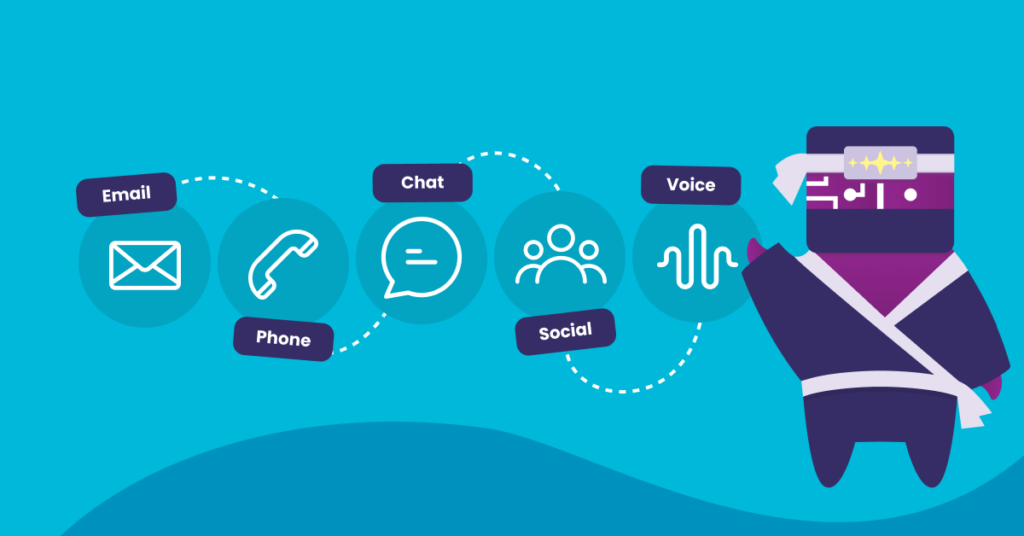
12. Helpdesk Hours
Tracking the number of hours or minutes an agent spends using their helpdesk will help you understand where your agents spend most of their time. You’ll be able to see how many tickets they resolve in a specific amount of time and pinpoint holes in productivity.
Pro Tip: If agents are spending a lot of time resolving long-term issues, this may be a sign that there is a snag in the process somewhere. Take a look at the full customer journey and see where you can improve it.
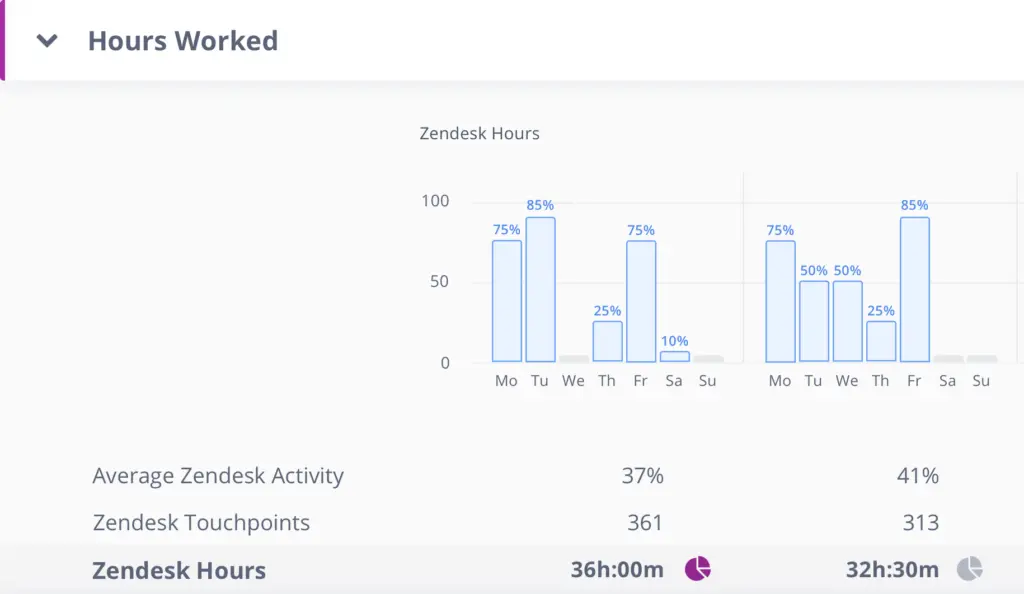
Using customer service scorecards to measure KPIs
There are many different customer support metrics you can track, but you’ll want to choose your KPIs wisely. Base them on your customer service and company goals and you’ll be able to identify the most important ones.
Getting these numbers may sound daunting, but when you can track your customer service KPIs in real-time with little effort, you can focus on more important things. That’s why we built Kaizo Scorecards to help you track progress, pinpoint outliers, and streamline capacity planning to get actionable team insights. If you’re looking to get everything from individual results to team forecasting in one place, Scorecards will help you get the full picture.
Moving forward with identifying the right KPIs to track
Customer service KPIs and metrics will help you and your team level up everything from your daily tasks to your annual goals. Determine exactly what those long-term goals are and work your way backward.
Ultimately, the combination of metrics you evaluate will help give your team direction. Make it both measurable and motivating, and involve agents in the process to make sure they support the decision and commit to the goals.
Identify the key metrics that relate most to your company and team goals so you can track and improve the right activities. From there, you can see all the progress you’ve made and where you can improve.
